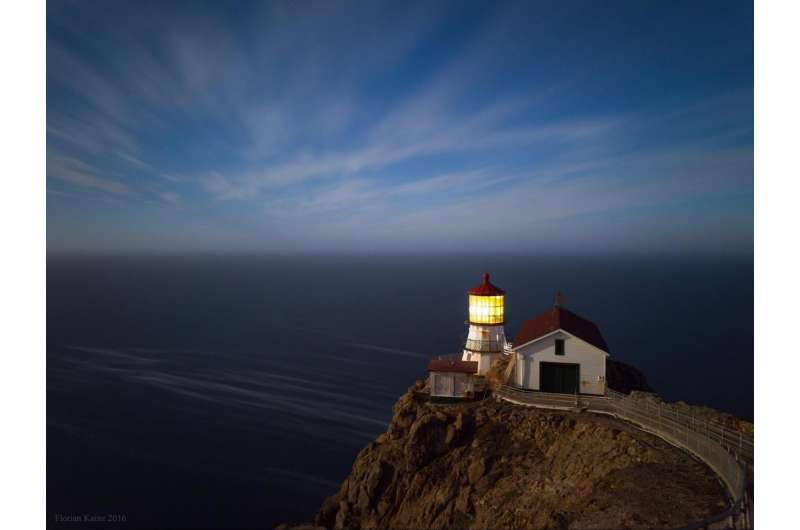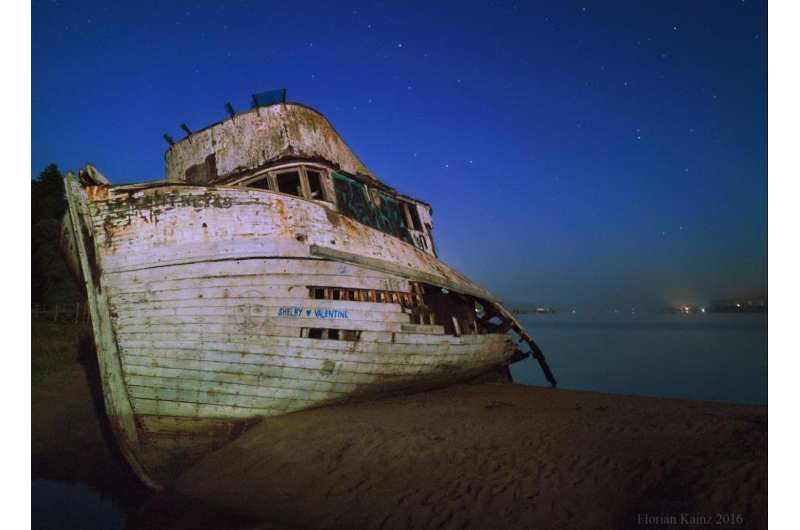April 30, 2017 weblog
Google software engineer describes nighttime photography using phones

(Tech Xplore)—Taking decent nighttime shots from your phone was the topic of an interesting blog posted earlier this month. An impressive account of low light photography with a cellphone was supported with interesting pictures, with the Google researcher resolved to push the limits.
Posting on the Google Research Blog earlier this month, Florian Kainz, software engineer, Google Daydream, talked about what he did with an experimental app, and cameras such as the Google Pixel and Nexus 6P. (Engadget said that a burst shot technique could take solid photos even in near-total darkness.")
Kainz wrote about one night last year when he carried a DSLR [digital single-lens reflex] camera, heavy lens and tripod up a hilltop. His goal: to capture the Golden Gate Bridge and the lights of the city behind it.
Seeing his night photo, a researcher challenged Kainz: Do the shot again, this time with a phone camera. Huh? Ditch a DLSR for such an outcome? OK.
Kainz accepted the challenge. "To learn what was possible with a cellphone camera in extremely low-light conditions, I looked to the experimental SeeInTheDark app, written by Marc Levoy and presented at the ICCV 2015 Extreme Imaging Workshop," he said.
"With SeeInTheDark it is just possible to take pictures, albeit fairly grainy ones, by the light of the full moon."
Kainz wrote an Android camera app, he said, with manual control over exposure time, ISO and focus distance.
(Jon Fingas, Engadget, commented how the Android app "helps take exceptionally clean photos in even the darkest conditions. The software gives you manual control over exposure, focus distance and ISO sensitivity, all of which are crucial to low-light photography.")
To test the app, he went to the Point Reyes lighthouse on the California coast on a full moon night.

"When the shutter button is pressed the app waits a few seconds and then records up to 64 frames with the selected settings. The app saves the raw frames captured from the sensor as DNG files, which can later be downloaded onto a PC for processing."
[DNG stands for Digital Negative Graphics file format.]
He used a Nexus 6P phone. He shot a burst of 32 four-second frames at ISO 1600.
Then he shot an additional 32 black frames after covering the camera lens with opaque adhesive tape.
He loaded the raw files into Photoshop when he got back to the office.
He showed he resulting image, on the blog; he thought it looked "surprisingly good." with "pleasing, natural looking colors."
He showed some more shots, but his curiosity was not satisfied.
What about using even less light?
The pictures he had shown were shot on nights with a full moon, but now he wanted to see what could be achieved with less light.
"Using a Pixel phone, I tried a scene illuminated by a three-quarter moon low in the sky, and another one with no moon at all. Anticipating more noise in the individual exposures, I shot 64-frame bursts." He said the processed final images still looked fine.
Fingas, assessing the experiments, concluded that "Google's Nexus 6P and Pixel could take well-exposed, color-accurate and largely noise-free photos in extremely dark situations. Kainz even managed a decent photo of the night sky using nothing but starlight. The approach can compensate for motion, too, so you might not need a tripod to stabilize your phone."
(Google Nexus 6P and Pixel phones "support exposure times of 4 and 2 seconds respectively," Kainz said.)
Viewer reaction on the blog: "You can take good pics with any camera. But a high end camera makes it easier (if you know how to use it). To take a good pic with a phone, you need a lot of precision and luck to some extent."
Another comment: "Trying to find out if phone cameras might be suitable for outdoor nighttime photography was a fun experiment, and clearly the result is yes, they are. However, arriving at the final images required a lot of careful post-processing on a desktop computer."
That latter comment brings us to Fingas' view. "Right now, the approach isn't practical for most people. It requires a lot of after-the-fact processing on a computer, and the pictures still aren't as high-resolution as what you tend to get out of DSLRs. Also, you certainly wouldn't want to use this for fast-moving objects."
Nonetheless, Fingas also said that "Kainz believes that a phone could handle everything by itself with the appropriate app. If the experiment translates from Google's labs to real-world code, you could take many nighttime photos that are virtually impossible today."
You can check out an album of Nexus and Pixel photography experiments here.
More information: research.googleblog.com/2017/0 … hotography-with.html
© 2017 Tech Xplore





















